An Analysis of Consumer Behavior in McDonalds Australia: Report
VerifiedAdded on 2021/05/30
|22
|5293
|50
Report
AI Summary
This report delves into the behavior of consumers within the McDonald's Australia market. It begins with an overview of McDonald's presence in Australia, highlighting its history, product offerings, and geographical distribution. The report then examines consumer perception, including price and benefit perceptions, and how Weber's Law influences customer behavior. It explores motivation, needs, and goals, differentiating between positivism and negativism in consumer decision-making. Maslow's hierarchy of needs is applied to understand consumer motivations. The 7Ps of marketing (product, price, promotion, place, process, physical evidence) are analyzed. Finally, the report concludes with recommendations based on the findings. This report identifies customer behaviors to help McDonald's sustain its position in the Australian food market.
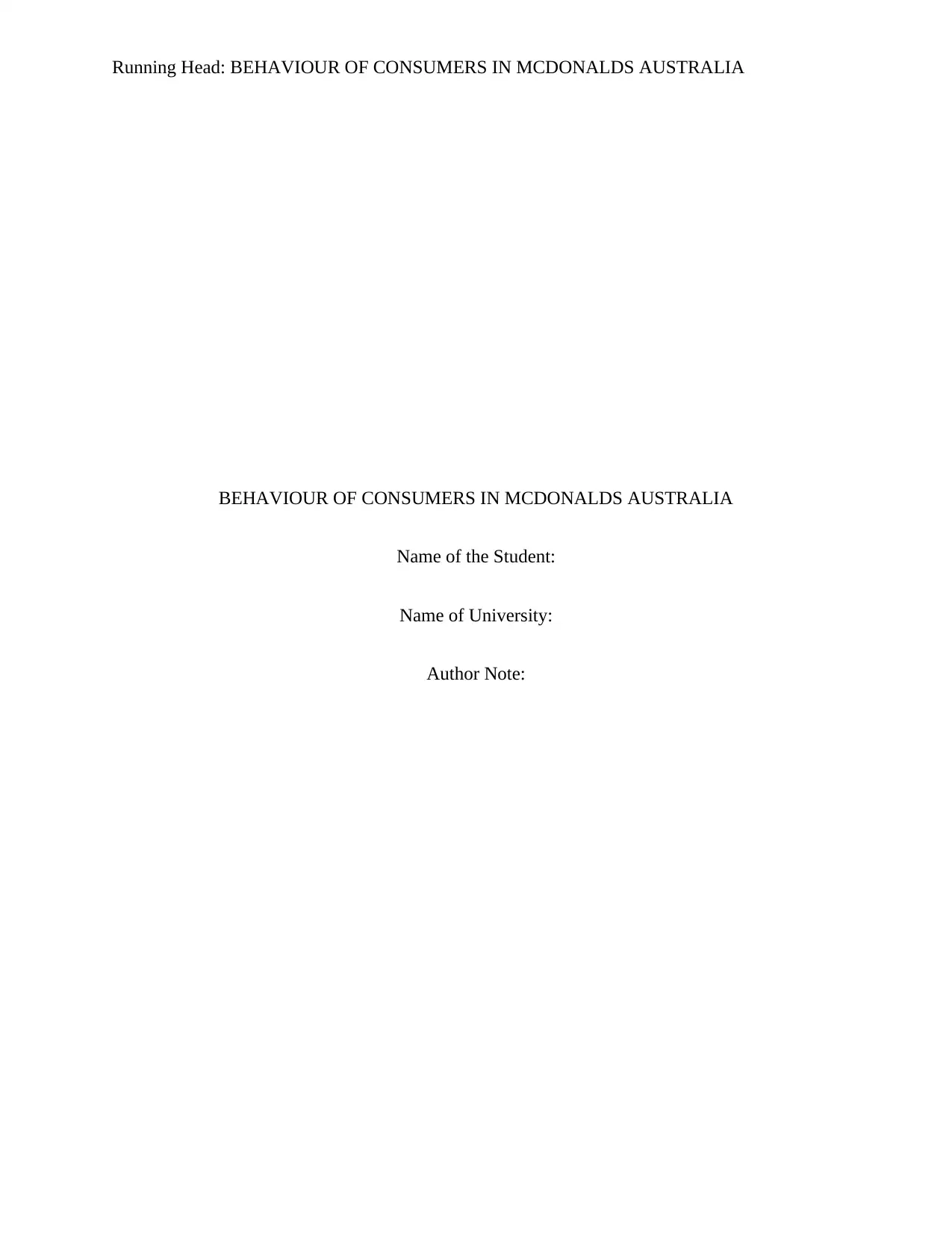
Running Head: BEHAVIOUR OF CONSUMERS IN MCDONALDS AUSTRALIA
BEHAVIOUR OF CONSUMERS IN MCDONALDS AUSTRALIA
Name of the Student:
Name of University:
Author Note:
BEHAVIOUR OF CONSUMERS IN MCDONALDS AUSTRALIA
Name of the Student:
Name of University:
Author Note:
Paraphrase This Document
Need a fresh take? Get an instant paraphrase of this document with our AI Paraphraser
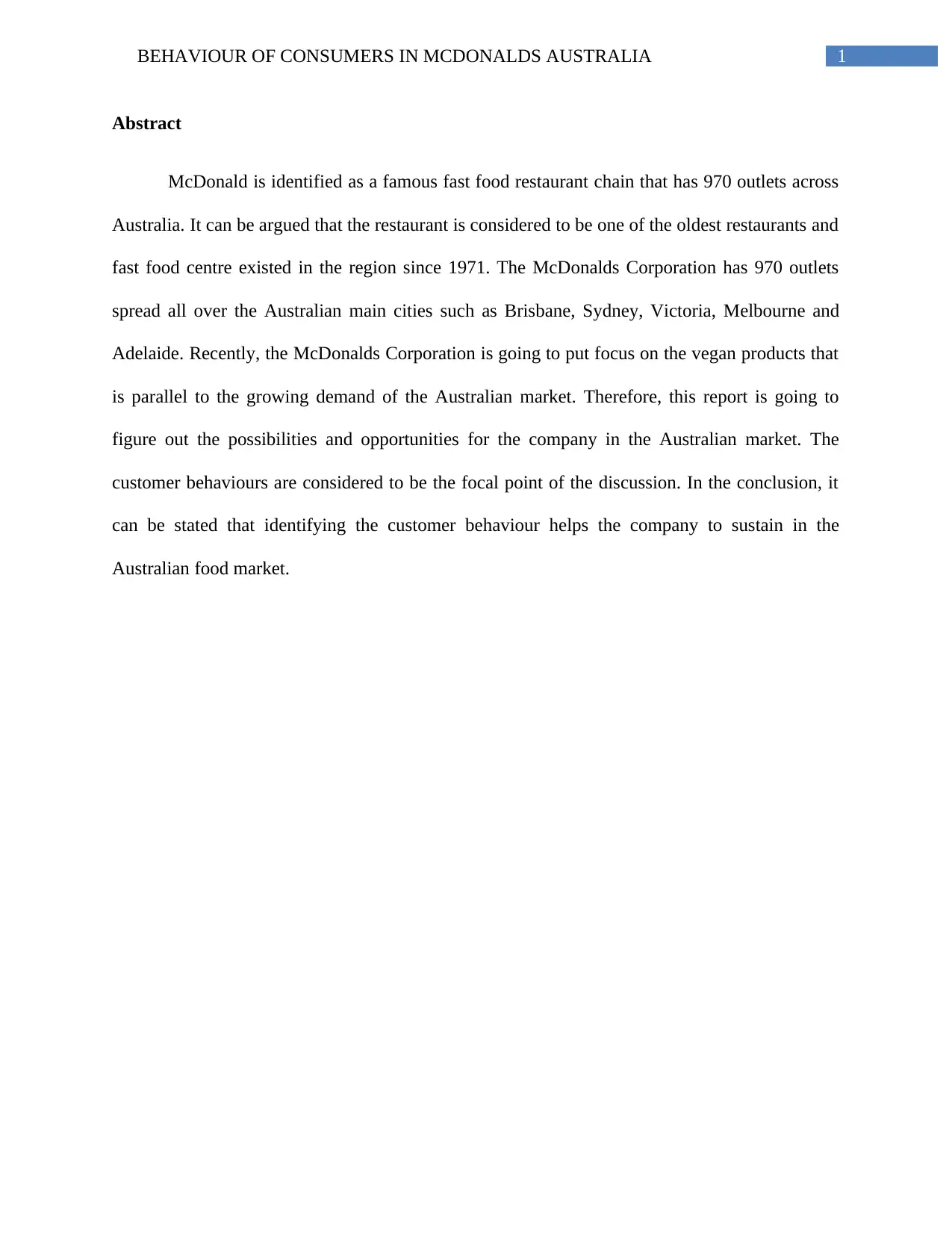
1BEHAVIOUR OF CONSUMERS IN MCDONALDS AUSTRALIA
Abstract
McDonald is identified as a famous fast food restaurant chain that has 970 outlets across
Australia. It can be argued that the restaurant is considered to be one of the oldest restaurants and
fast food centre existed in the region since 1971. The McDonalds Corporation has 970 outlets
spread all over the Australian main cities such as Brisbane, Sydney, Victoria, Melbourne and
Adelaide. Recently, the McDonalds Corporation is going to put focus on the vegan products that
is parallel to the growing demand of the Australian market. Therefore, this report is going to
figure out the possibilities and opportunities for the company in the Australian market. The
customer behaviours are considered to be the focal point of the discussion. In the conclusion, it
can be stated that identifying the customer behaviour helps the company to sustain in the
Australian food market.
Abstract
McDonald is identified as a famous fast food restaurant chain that has 970 outlets across
Australia. It can be argued that the restaurant is considered to be one of the oldest restaurants and
fast food centre existed in the region since 1971. The McDonalds Corporation has 970 outlets
spread all over the Australian main cities such as Brisbane, Sydney, Victoria, Melbourne and
Adelaide. Recently, the McDonalds Corporation is going to put focus on the vegan products that
is parallel to the growing demand of the Australian market. Therefore, this report is going to
figure out the possibilities and opportunities for the company in the Australian market. The
customer behaviours are considered to be the focal point of the discussion. In the conclusion, it
can be stated that identifying the customer behaviour helps the company to sustain in the
Australian food market.
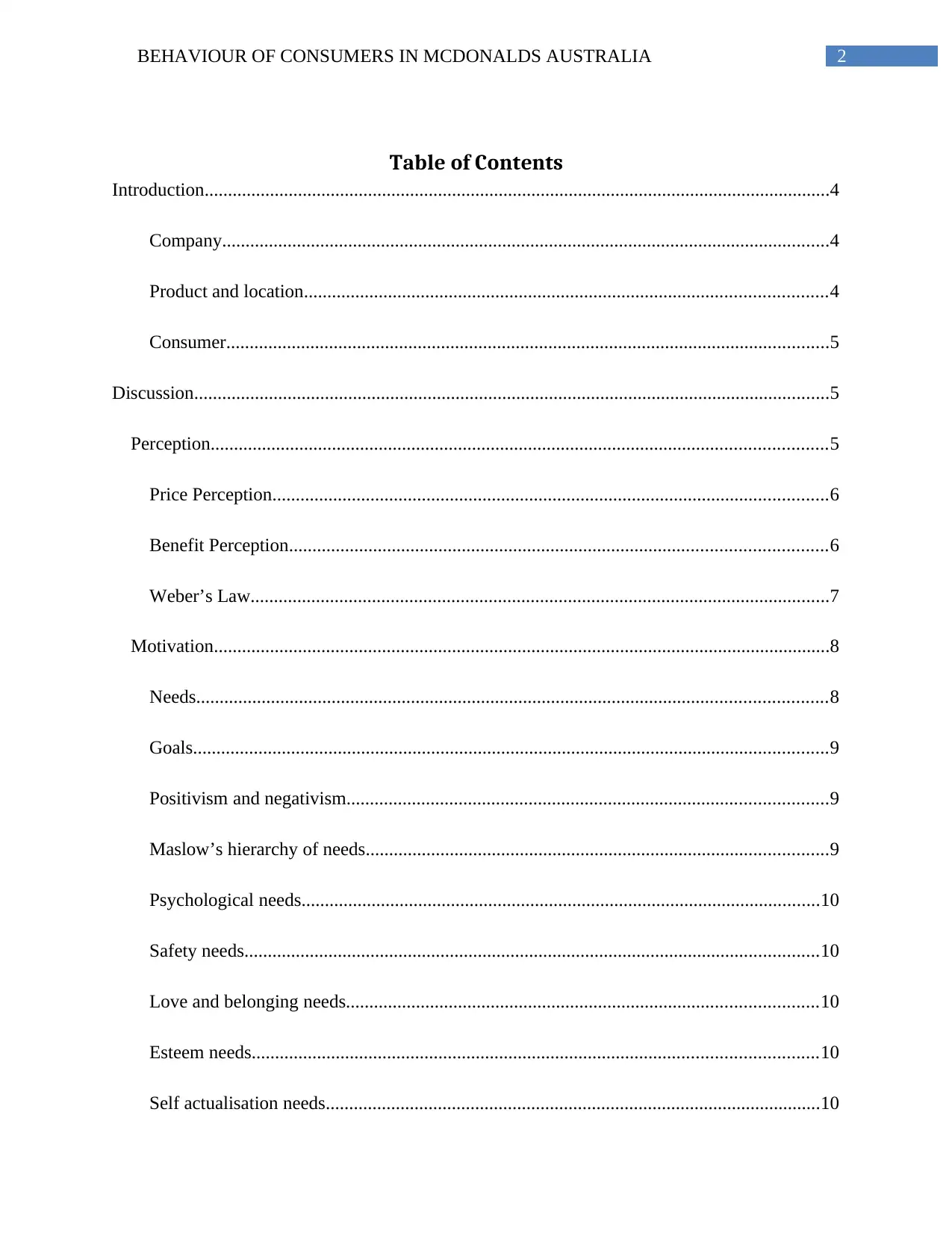
2BEHAVIOUR OF CONSUMERS IN MCDONALDS AUSTRALIA
Table of Contents
Introduction......................................................................................................................................4
Company..................................................................................................................................4
Product and location................................................................................................................4
Consumer.................................................................................................................................5
Discussion........................................................................................................................................5
Perception....................................................................................................................................5
Price Perception.......................................................................................................................6
Benefit Perception...................................................................................................................6
Weber’s Law............................................................................................................................7
Motivation....................................................................................................................................8
Needs.......................................................................................................................................8
Goals........................................................................................................................................9
Positivism and negativism.......................................................................................................9
Maslow’s hierarchy of needs...................................................................................................9
Psychological needs...............................................................................................................10
Safety needs...........................................................................................................................10
Love and belonging needs.....................................................................................................10
Esteem needs.........................................................................................................................10
Self actualisation needs..........................................................................................................10
Table of Contents
Introduction......................................................................................................................................4
Company..................................................................................................................................4
Product and location................................................................................................................4
Consumer.................................................................................................................................5
Discussion........................................................................................................................................5
Perception....................................................................................................................................5
Price Perception.......................................................................................................................6
Benefit Perception...................................................................................................................6
Weber’s Law............................................................................................................................7
Motivation....................................................................................................................................8
Needs.......................................................................................................................................8
Goals........................................................................................................................................9
Positivism and negativism.......................................................................................................9
Maslow’s hierarchy of needs...................................................................................................9
Psychological needs...............................................................................................................10
Safety needs...........................................................................................................................10
Love and belonging needs.....................................................................................................10
Esteem needs.........................................................................................................................10
Self actualisation needs..........................................................................................................10
⊘ This is a preview!⊘
Do you want full access?
Subscribe today to unlock all pages.

Trusted by 1+ million students worldwide
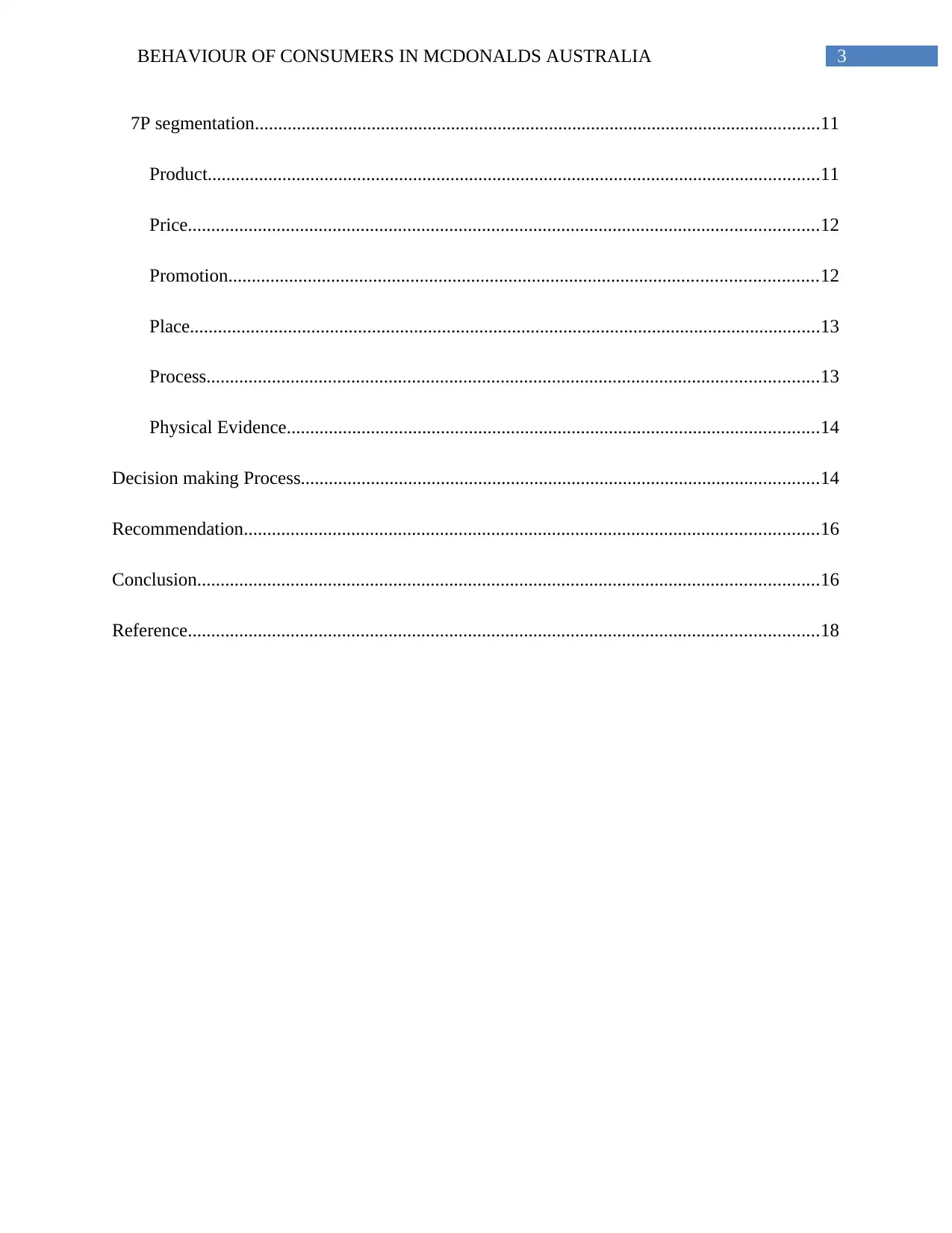
3BEHAVIOUR OF CONSUMERS IN MCDONALDS AUSTRALIA
7P segmentation.........................................................................................................................11
Product...................................................................................................................................11
Price.......................................................................................................................................12
Promotion..............................................................................................................................12
Place.......................................................................................................................................13
Process...................................................................................................................................13
Physical Evidence..................................................................................................................14
Decision making Process...............................................................................................................14
Recommendation...........................................................................................................................16
Conclusion.....................................................................................................................................16
Reference.......................................................................................................................................18
7P segmentation.........................................................................................................................11
Product...................................................................................................................................11
Price.......................................................................................................................................12
Promotion..............................................................................................................................12
Place.......................................................................................................................................13
Process...................................................................................................................................13
Physical Evidence..................................................................................................................14
Decision making Process...............................................................................................................14
Recommendation...........................................................................................................................16
Conclusion.....................................................................................................................................16
Reference.......................................................................................................................................18
Paraphrase This Document
Need a fresh take? Get an instant paraphrase of this document with our AI Paraphraser
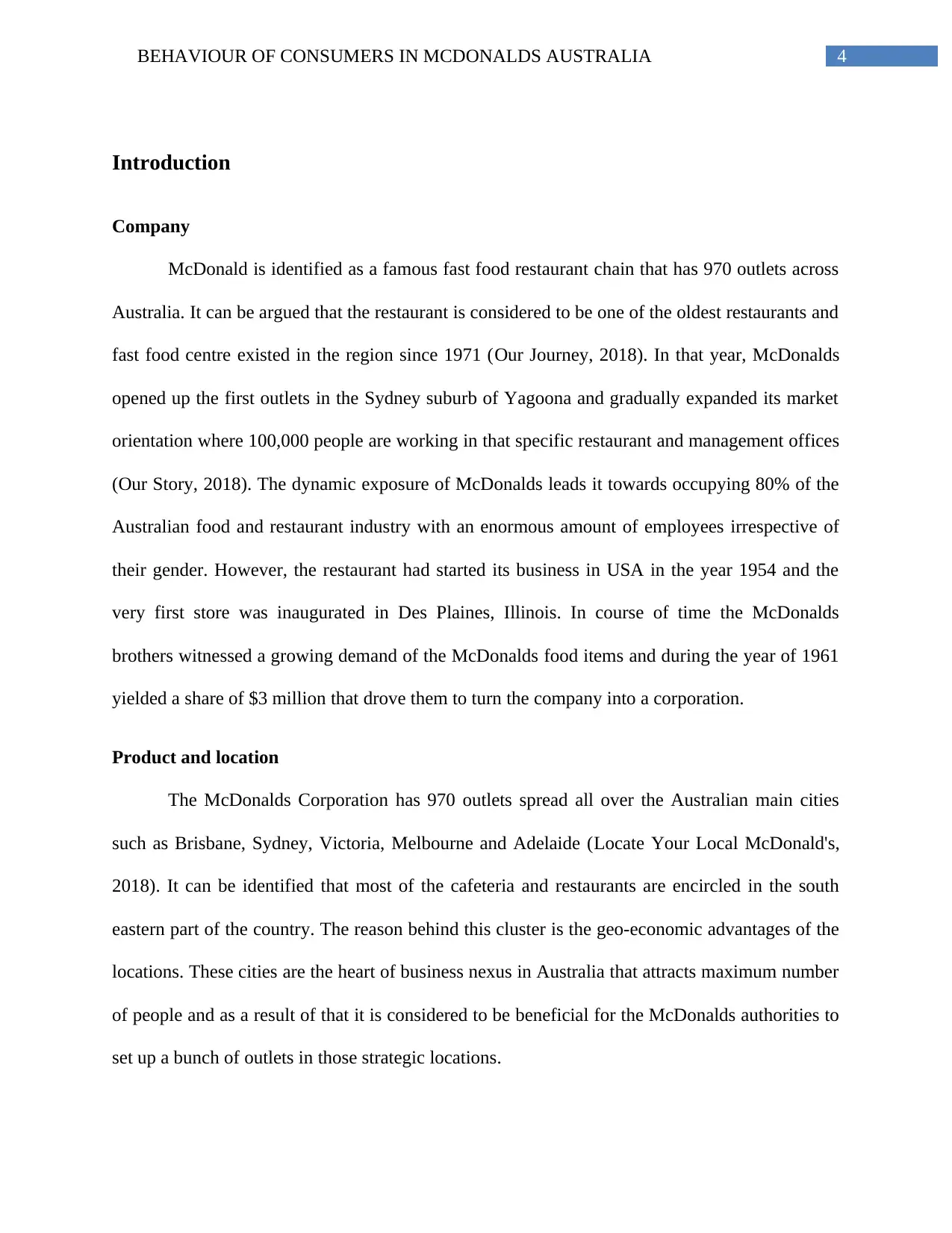
4BEHAVIOUR OF CONSUMERS IN MCDONALDS AUSTRALIA
Introduction
Company
McDonald is identified as a famous fast food restaurant chain that has 970 outlets across
Australia. It can be argued that the restaurant is considered to be one of the oldest restaurants and
fast food centre existed in the region since 1971 (Our Journey, 2018). In that year, McDonalds
opened up the first outlets in the Sydney suburb of Yagoona and gradually expanded its market
orientation where 100,000 people are working in that specific restaurant and management offices
(Our Story, 2018). The dynamic exposure of McDonalds leads it towards occupying 80% of the
Australian food and restaurant industry with an enormous amount of employees irrespective of
their gender. However, the restaurant had started its business in USA in the year 1954 and the
very first store was inaugurated in Des Plaines, Illinois. In course of time the McDonalds
brothers witnessed a growing demand of the McDonalds food items and during the year of 1961
yielded a share of $3 million that drove them to turn the company into a corporation.
Product and location
The McDonalds Corporation has 970 outlets spread all over the Australian main cities
such as Brisbane, Sydney, Victoria, Melbourne and Adelaide (Locate Your Local McDonald's,
2018). It can be identified that most of the cafeteria and restaurants are encircled in the south
eastern part of the country. The reason behind this cluster is the geo-economic advantages of the
locations. These cities are the heart of business nexus in Australia that attracts maximum number
of people and as a result of that it is considered to be beneficial for the McDonalds authorities to
set up a bunch of outlets in those strategic locations.
Introduction
Company
McDonald is identified as a famous fast food restaurant chain that has 970 outlets across
Australia. It can be argued that the restaurant is considered to be one of the oldest restaurants and
fast food centre existed in the region since 1971 (Our Journey, 2018). In that year, McDonalds
opened up the first outlets in the Sydney suburb of Yagoona and gradually expanded its market
orientation where 100,000 people are working in that specific restaurant and management offices
(Our Story, 2018). The dynamic exposure of McDonalds leads it towards occupying 80% of the
Australian food and restaurant industry with an enormous amount of employees irrespective of
their gender. However, the restaurant had started its business in USA in the year 1954 and the
very first store was inaugurated in Des Plaines, Illinois. In course of time the McDonalds
brothers witnessed a growing demand of the McDonalds food items and during the year of 1961
yielded a share of $3 million that drove them to turn the company into a corporation.
Product and location
The McDonalds Corporation has 970 outlets spread all over the Australian main cities
such as Brisbane, Sydney, Victoria, Melbourne and Adelaide (Locate Your Local McDonald's,
2018). It can be identified that most of the cafeteria and restaurants are encircled in the south
eastern part of the country. The reason behind this cluster is the geo-economic advantages of the
locations. These cities are the heart of business nexus in Australia that attracts maximum number
of people and as a result of that it is considered to be beneficial for the McDonalds authorities to
set up a bunch of outlets in those strategic locations.
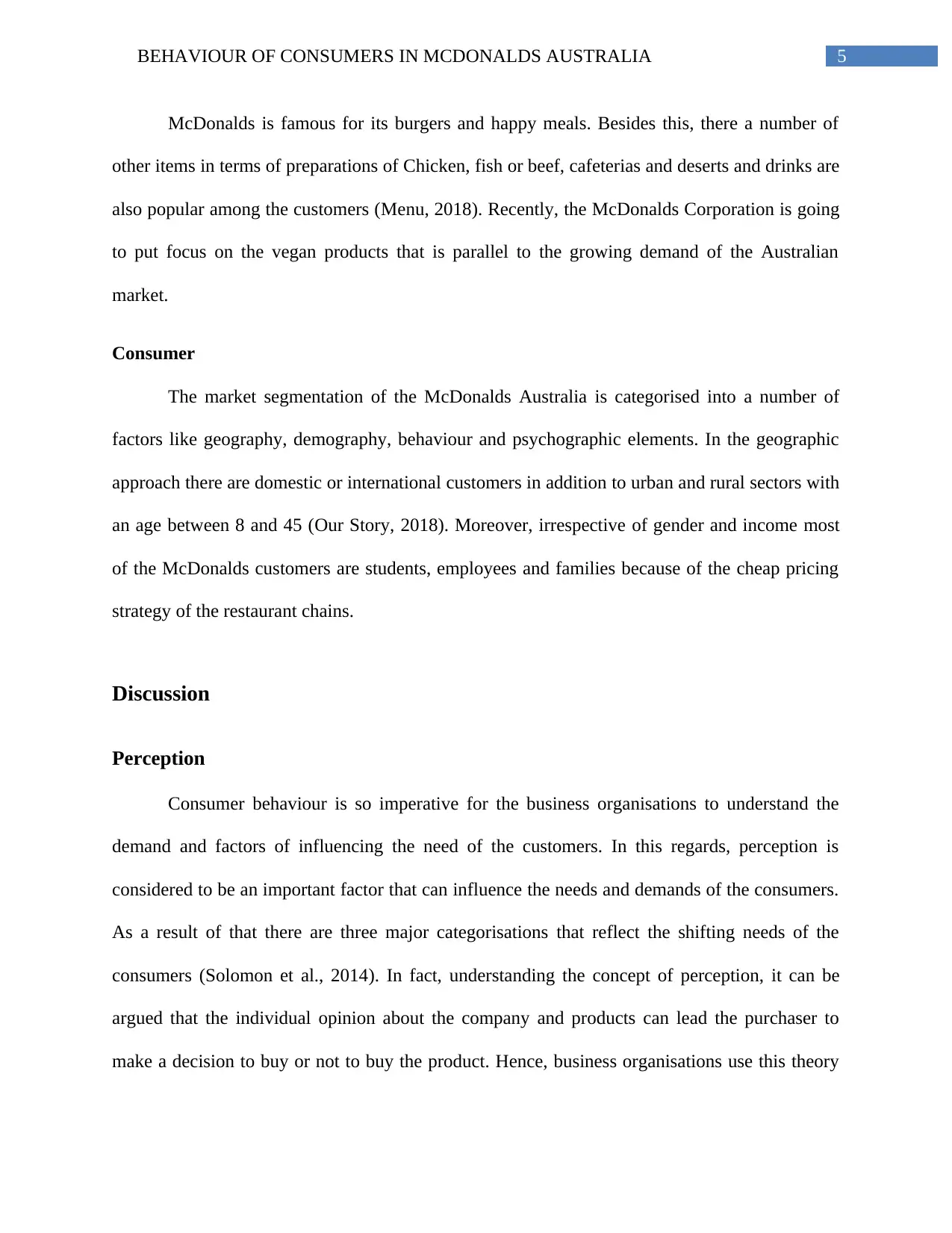
5BEHAVIOUR OF CONSUMERS IN MCDONALDS AUSTRALIA
McDonalds is famous for its burgers and happy meals. Besides this, there a number of
other items in terms of preparations of Chicken, fish or beef, cafeterias and deserts and drinks are
also popular among the customers (Menu, 2018). Recently, the McDonalds Corporation is going
to put focus on the vegan products that is parallel to the growing demand of the Australian
market.
Consumer
The market segmentation of the McDonalds Australia is categorised into a number of
factors like geography, demography, behaviour and psychographic elements. In the geographic
approach there are domestic or international customers in addition to urban and rural sectors with
an age between 8 and 45 (Our Story, 2018). Moreover, irrespective of gender and income most
of the McDonalds customers are students, employees and families because of the cheap pricing
strategy of the restaurant chains.
Discussion
Perception
Consumer behaviour is so imperative for the business organisations to understand the
demand and factors of influencing the need of the customers. In this regards, perception is
considered to be an important factor that can influence the needs and demands of the consumers.
As a result of that there are three major categorisations that reflect the shifting needs of the
consumers (Solomon et al., 2014). In fact, understanding the concept of perception, it can be
argued that the individual opinion about the company and products can lead the purchaser to
make a decision to buy or not to buy the product. Hence, business organisations use this theory
McDonalds is famous for its burgers and happy meals. Besides this, there a number of
other items in terms of preparations of Chicken, fish or beef, cafeterias and deserts and drinks are
also popular among the customers (Menu, 2018). Recently, the McDonalds Corporation is going
to put focus on the vegan products that is parallel to the growing demand of the Australian
market.
Consumer
The market segmentation of the McDonalds Australia is categorised into a number of
factors like geography, demography, behaviour and psychographic elements. In the geographic
approach there are domestic or international customers in addition to urban and rural sectors with
an age between 8 and 45 (Our Story, 2018). Moreover, irrespective of gender and income most
of the McDonalds customers are students, employees and families because of the cheap pricing
strategy of the restaurant chains.
Discussion
Perception
Consumer behaviour is so imperative for the business organisations to understand the
demand and factors of influencing the need of the customers. In this regards, perception is
considered to be an important factor that can influence the needs and demands of the consumers.
As a result of that there are three major categorisations that reflect the shifting needs of the
consumers (Solomon et al., 2014). In fact, understanding the concept of perception, it can be
argued that the individual opinion about the company and products can lead the purchaser to
make a decision to buy or not to buy the product. Hence, business organisations use this theory
⊘ This is a preview!⊘
Do you want full access?
Subscribe today to unlock all pages.

Trusted by 1+ million students worldwide
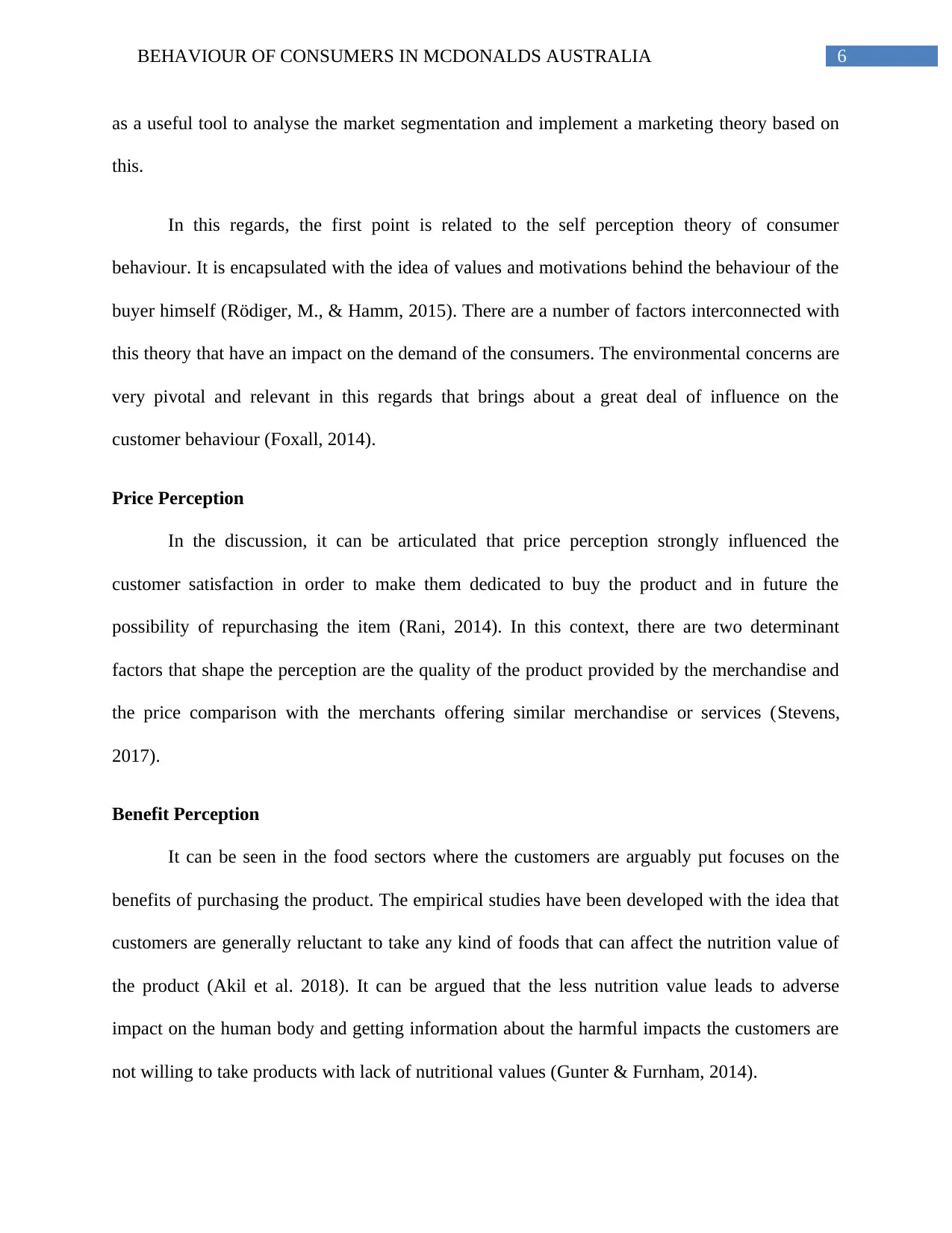
6BEHAVIOUR OF CONSUMERS IN MCDONALDS AUSTRALIA
as a useful tool to analyse the market segmentation and implement a marketing theory based on
this.
In this regards, the first point is related to the self perception theory of consumer
behaviour. It is encapsulated with the idea of values and motivations behind the behaviour of the
buyer himself (Rödiger, M., & Hamm, 2015). There are a number of factors interconnected with
this theory that have an impact on the demand of the consumers. The environmental concerns are
very pivotal and relevant in this regards that brings about a great deal of influence on the
customer behaviour (Foxall, 2014).
Price Perception
In the discussion, it can be articulated that price perception strongly influenced the
customer satisfaction in order to make them dedicated to buy the product and in future the
possibility of repurchasing the item (Rani, 2014). In this context, there are two determinant
factors that shape the perception are the quality of the product provided by the merchandise and
the price comparison with the merchants offering similar merchandise or services (Stevens,
2017).
Benefit Perception
It can be seen in the food sectors where the customers are arguably put focuses on the
benefits of purchasing the product. The empirical studies have been developed with the idea that
customers are generally reluctant to take any kind of foods that can affect the nutrition value of
the product (Akil et al. 2018). It can be argued that the less nutrition value leads to adverse
impact on the human body and getting information about the harmful impacts the customers are
not willing to take products with lack of nutritional values (Gunter & Furnham, 2014).
as a useful tool to analyse the market segmentation and implement a marketing theory based on
this.
In this regards, the first point is related to the self perception theory of consumer
behaviour. It is encapsulated with the idea of values and motivations behind the behaviour of the
buyer himself (Rödiger, M., & Hamm, 2015). There are a number of factors interconnected with
this theory that have an impact on the demand of the consumers. The environmental concerns are
very pivotal and relevant in this regards that brings about a great deal of influence on the
customer behaviour (Foxall, 2014).
Price Perception
In the discussion, it can be articulated that price perception strongly influenced the
customer satisfaction in order to make them dedicated to buy the product and in future the
possibility of repurchasing the item (Rani, 2014). In this context, there are two determinant
factors that shape the perception are the quality of the product provided by the merchandise and
the price comparison with the merchants offering similar merchandise or services (Stevens,
2017).
Benefit Perception
It can be seen in the food sectors where the customers are arguably put focuses on the
benefits of purchasing the product. The empirical studies have been developed with the idea that
customers are generally reluctant to take any kind of foods that can affect the nutrition value of
the product (Akil et al. 2018). It can be argued that the less nutrition value leads to adverse
impact on the human body and getting information about the harmful impacts the customers are
not willing to take products with lack of nutritional values (Gunter & Furnham, 2014).
Paraphrase This Document
Need a fresh take? Get an instant paraphrase of this document with our AI Paraphraser
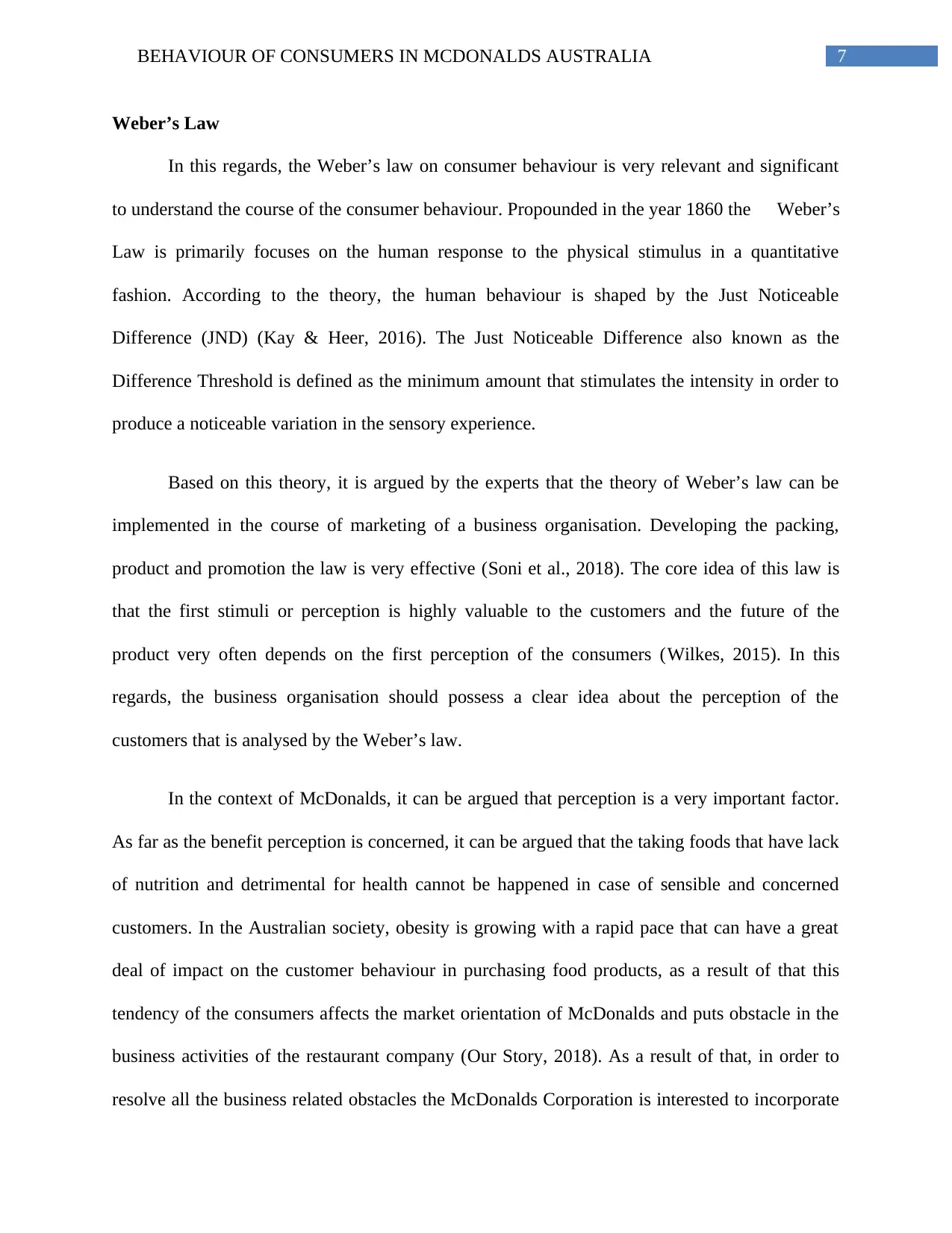
7BEHAVIOUR OF CONSUMERS IN MCDONALDS AUSTRALIA
Weber’s Law
In this regards, the Weber’s law on consumer behaviour is very relevant and significant
to understand the course of the consumer behaviour. Propounded in the year 1860 the Weber’s
Law is primarily focuses on the human response to the physical stimulus in a quantitative
fashion. According to the theory, the human behaviour is shaped by the Just Noticeable
Difference (JND) (Kay & Heer, 2016). The Just Noticeable Difference also known as the
Difference Threshold is defined as the minimum amount that stimulates the intensity in order to
produce a noticeable variation in the sensory experience.
Based on this theory, it is argued by the experts that the theory of Weber’s law can be
implemented in the course of marketing of a business organisation. Developing the packing,
product and promotion the law is very effective (Soni et al., 2018). The core idea of this law is
that the first stimuli or perception is highly valuable to the customers and the future of the
product very often depends on the first perception of the consumers (Wilkes, 2015). In this
regards, the business organisation should possess a clear idea about the perception of the
customers that is analysed by the Weber’s law.
In the context of McDonalds, it can be argued that perception is a very important factor.
As far as the benefit perception is concerned, it can be argued that the taking foods that have lack
of nutrition and detrimental for health cannot be happened in case of sensible and concerned
customers. In the Australian society, obesity is growing with a rapid pace that can have a great
deal of impact on the customer behaviour in purchasing food products, as a result of that this
tendency of the consumers affects the market orientation of McDonalds and puts obstacle in the
business activities of the restaurant company (Our Story, 2018). As a result of that, in order to
resolve all the business related obstacles the McDonalds Corporation is interested to incorporate
Weber’s Law
In this regards, the Weber’s law on consumer behaviour is very relevant and significant
to understand the course of the consumer behaviour. Propounded in the year 1860 the Weber’s
Law is primarily focuses on the human response to the physical stimulus in a quantitative
fashion. According to the theory, the human behaviour is shaped by the Just Noticeable
Difference (JND) (Kay & Heer, 2016). The Just Noticeable Difference also known as the
Difference Threshold is defined as the minimum amount that stimulates the intensity in order to
produce a noticeable variation in the sensory experience.
Based on this theory, it is argued by the experts that the theory of Weber’s law can be
implemented in the course of marketing of a business organisation. Developing the packing,
product and promotion the law is very effective (Soni et al., 2018). The core idea of this law is
that the first stimuli or perception is highly valuable to the customers and the future of the
product very often depends on the first perception of the consumers (Wilkes, 2015). In this
regards, the business organisation should possess a clear idea about the perception of the
customers that is analysed by the Weber’s law.
In the context of McDonalds, it can be argued that perception is a very important factor.
As far as the benefit perception is concerned, it can be argued that the taking foods that have lack
of nutrition and detrimental for health cannot be happened in case of sensible and concerned
customers. In the Australian society, obesity is growing with a rapid pace that can have a great
deal of impact on the customer behaviour in purchasing food products, as a result of that this
tendency of the consumers affects the market orientation of McDonalds and puts obstacle in the
business activities of the restaurant company (Our Story, 2018). As a result of that, in order to
resolve all the business related obstacles the McDonalds Corporation is interested to incorporate
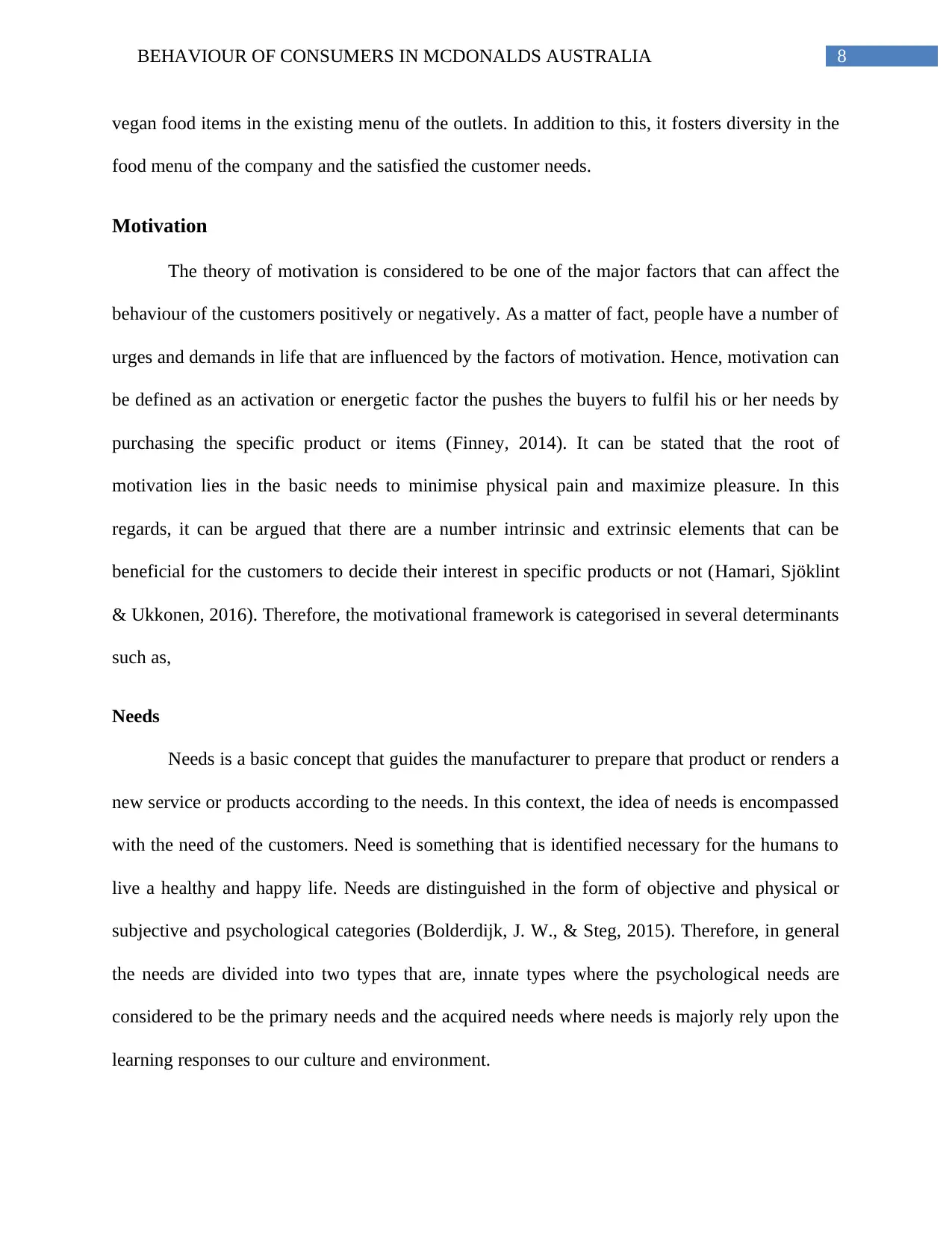
8BEHAVIOUR OF CONSUMERS IN MCDONALDS AUSTRALIA
vegan food items in the existing menu of the outlets. In addition to this, it fosters diversity in the
food menu of the company and the satisfied the customer needs.
Motivation
The theory of motivation is considered to be one of the major factors that can affect the
behaviour of the customers positively or negatively. As a matter of fact, people have a number of
urges and demands in life that are influenced by the factors of motivation. Hence, motivation can
be defined as an activation or energetic factor the pushes the buyers to fulfil his or her needs by
purchasing the specific product or items (Finney, 2014). It can be stated that the root of
motivation lies in the basic needs to minimise physical pain and maximize pleasure. In this
regards, it can be argued that there are a number intrinsic and extrinsic elements that can be
beneficial for the customers to decide their interest in specific products or not (Hamari, Sjöklint
& Ukkonen, 2016). Therefore, the motivational framework is categorised in several determinants
such as,
Needs
Needs is a basic concept that guides the manufacturer to prepare that product or renders a
new service or products according to the needs. In this context, the idea of needs is encompassed
with the need of the customers. Need is something that is identified necessary for the humans to
live a healthy and happy life. Needs are distinguished in the form of objective and physical or
subjective and psychological categories (Bolderdijk, J. W., & Steg, 2015). Therefore, in general
the needs are divided into two types that are, innate types where the psychological needs are
considered to be the primary needs and the acquired needs where needs is majorly rely upon the
learning responses to our culture and environment.
vegan food items in the existing menu of the outlets. In addition to this, it fosters diversity in the
food menu of the company and the satisfied the customer needs.
Motivation
The theory of motivation is considered to be one of the major factors that can affect the
behaviour of the customers positively or negatively. As a matter of fact, people have a number of
urges and demands in life that are influenced by the factors of motivation. Hence, motivation can
be defined as an activation or energetic factor the pushes the buyers to fulfil his or her needs by
purchasing the specific product or items (Finney, 2014). It can be stated that the root of
motivation lies in the basic needs to minimise physical pain and maximize pleasure. In this
regards, it can be argued that there are a number intrinsic and extrinsic elements that can be
beneficial for the customers to decide their interest in specific products or not (Hamari, Sjöklint
& Ukkonen, 2016). Therefore, the motivational framework is categorised in several determinants
such as,
Needs
Needs is a basic concept that guides the manufacturer to prepare that product or renders a
new service or products according to the needs. In this context, the idea of needs is encompassed
with the need of the customers. Need is something that is identified necessary for the humans to
live a healthy and happy life. Needs are distinguished in the form of objective and physical or
subjective and psychological categories (Bolderdijk, J. W., & Steg, 2015). Therefore, in general
the needs are divided into two types that are, innate types where the psychological needs are
considered to be the primary needs and the acquired needs where needs is majorly rely upon the
learning responses to our culture and environment.
⊘ This is a preview!⊘
Do you want full access?
Subscribe today to unlock all pages.

Trusted by 1+ million students worldwide
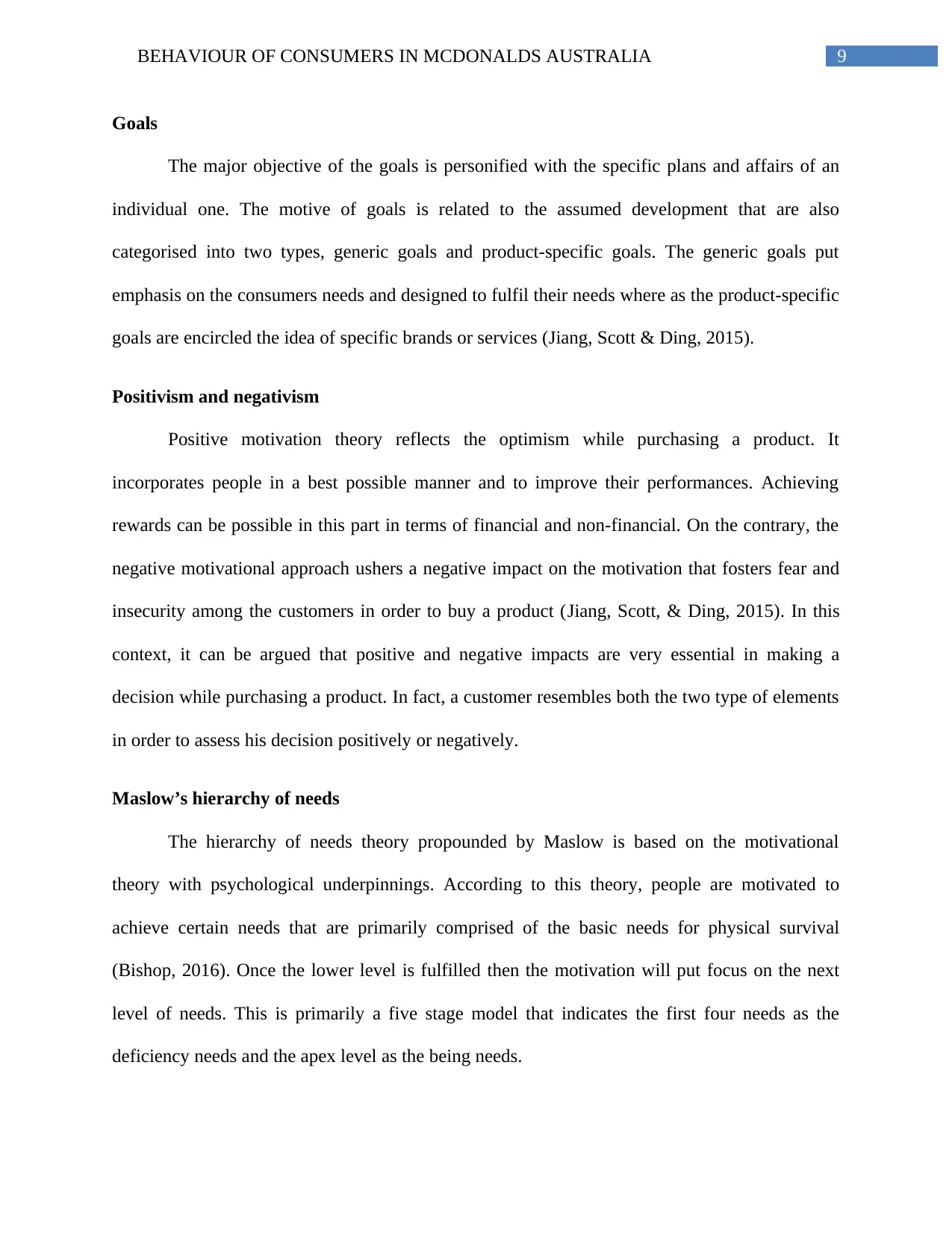
9BEHAVIOUR OF CONSUMERS IN MCDONALDS AUSTRALIA
Goals
The major objective of the goals is personified with the specific plans and affairs of an
individual one. The motive of goals is related to the assumed development that are also
categorised into two types, generic goals and product-specific goals. The generic goals put
emphasis on the consumers needs and designed to fulfil their needs where as the product-specific
goals are encircled the idea of specific brands or services (Jiang, Scott & Ding, 2015).
Positivism and negativism
Positive motivation theory reflects the optimism while purchasing a product. It
incorporates people in a best possible manner and to improve their performances. Achieving
rewards can be possible in this part in terms of financial and non-financial. On the contrary, the
negative motivational approach ushers a negative impact on the motivation that fosters fear and
insecurity among the customers in order to buy a product (Jiang, Scott, & Ding, 2015). In this
context, it can be argued that positive and negative impacts are very essential in making a
decision while purchasing a product. In fact, a customer resembles both the two type of elements
in order to assess his decision positively or negatively.
Maslow’s hierarchy of needs
The hierarchy of needs theory propounded by Maslow is based on the motivational
theory with psychological underpinnings. According to this theory, people are motivated to
achieve certain needs that are primarily comprised of the basic needs for physical survival
(Bishop, 2016). Once the lower level is fulfilled then the motivation will put focus on the next
level of needs. This is primarily a five stage model that indicates the first four needs as the
deficiency needs and the apex level as the being needs.
Goals
The major objective of the goals is personified with the specific plans and affairs of an
individual one. The motive of goals is related to the assumed development that are also
categorised into two types, generic goals and product-specific goals. The generic goals put
emphasis on the consumers needs and designed to fulfil their needs where as the product-specific
goals are encircled the idea of specific brands or services (Jiang, Scott & Ding, 2015).
Positivism and negativism
Positive motivation theory reflects the optimism while purchasing a product. It
incorporates people in a best possible manner and to improve their performances. Achieving
rewards can be possible in this part in terms of financial and non-financial. On the contrary, the
negative motivational approach ushers a negative impact on the motivation that fosters fear and
insecurity among the customers in order to buy a product (Jiang, Scott, & Ding, 2015). In this
context, it can be argued that positive and negative impacts are very essential in making a
decision while purchasing a product. In fact, a customer resembles both the two type of elements
in order to assess his decision positively or negatively.
Maslow’s hierarchy of needs
The hierarchy of needs theory propounded by Maslow is based on the motivational
theory with psychological underpinnings. According to this theory, people are motivated to
achieve certain needs that are primarily comprised of the basic needs for physical survival
(Bishop, 2016). Once the lower level is fulfilled then the motivation will put focus on the next
level of needs. This is primarily a five stage model that indicates the first four needs as the
deficiency needs and the apex level as the being needs.
Paraphrase This Document
Need a fresh take? Get an instant paraphrase of this document with our AI Paraphraser
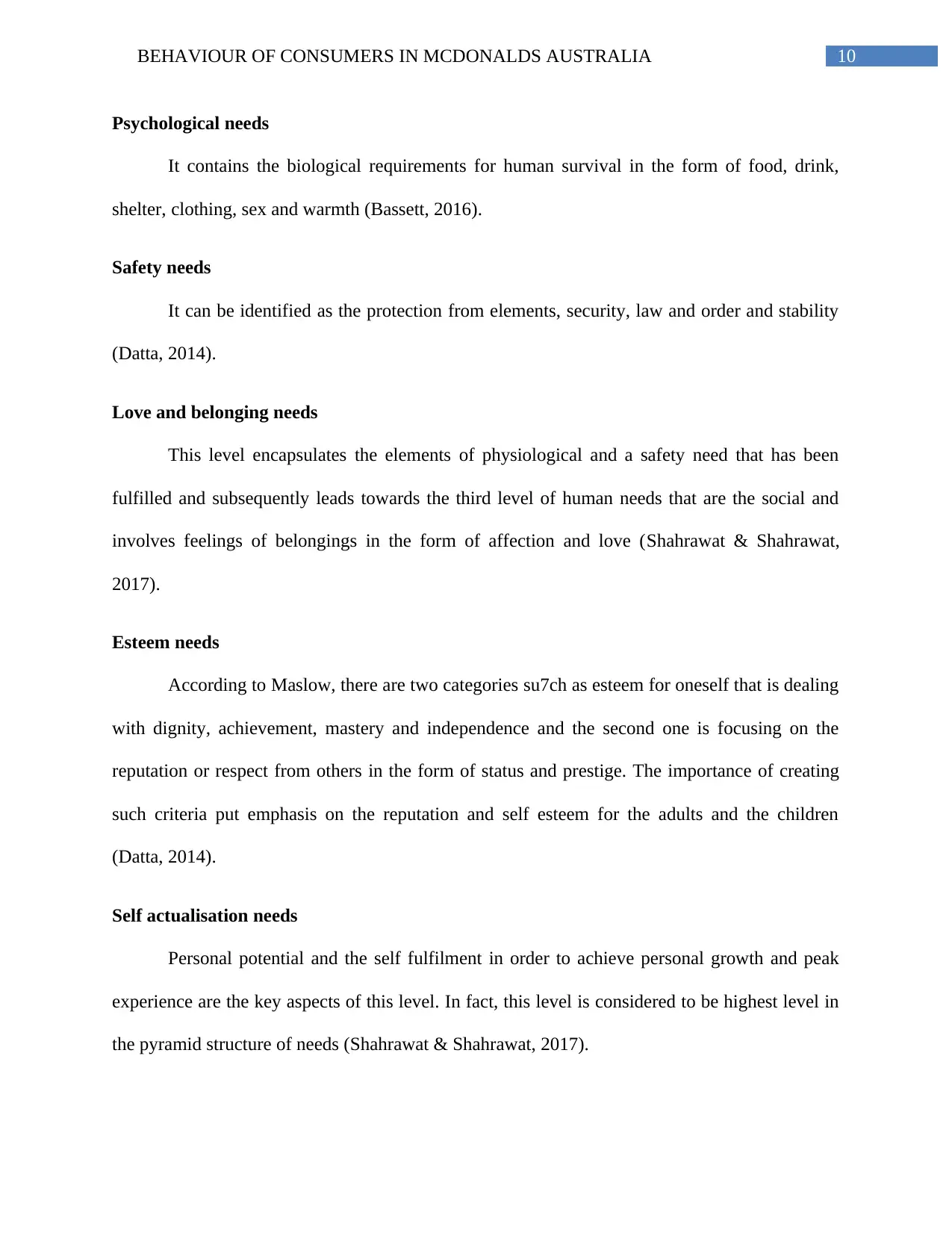
10BEHAVIOUR OF CONSUMERS IN MCDONALDS AUSTRALIA
Psychological needs
It contains the biological requirements for human survival in the form of food, drink,
shelter, clothing, sex and warmth (Bassett, 2016).
Safety needs
It can be identified as the protection from elements, security, law and order and stability
(Datta, 2014).
Love and belonging needs
This level encapsulates the elements of physiological and a safety need that has been
fulfilled and subsequently leads towards the third level of human needs that are the social and
involves feelings of belongings in the form of affection and love (Shahrawat & Shahrawat,
2017).
Esteem needs
According to Maslow, there are two categories su7ch as esteem for oneself that is dealing
with dignity, achievement, mastery and independence and the second one is focusing on the
reputation or respect from others in the form of status and prestige. The importance of creating
such criteria put emphasis on the reputation and self esteem for the adults and the children
(Datta, 2014).
Self actualisation needs
Personal potential and the self fulfilment in order to achieve personal growth and peak
experience are the key aspects of this level. In fact, this level is considered to be highest level in
the pyramid structure of needs (Shahrawat & Shahrawat, 2017).
Psychological needs
It contains the biological requirements for human survival in the form of food, drink,
shelter, clothing, sex and warmth (Bassett, 2016).
Safety needs
It can be identified as the protection from elements, security, law and order and stability
(Datta, 2014).
Love and belonging needs
This level encapsulates the elements of physiological and a safety need that has been
fulfilled and subsequently leads towards the third level of human needs that are the social and
involves feelings of belongings in the form of affection and love (Shahrawat & Shahrawat,
2017).
Esteem needs
According to Maslow, there are two categories su7ch as esteem for oneself that is dealing
with dignity, achievement, mastery and independence and the second one is focusing on the
reputation or respect from others in the form of status and prestige. The importance of creating
such criteria put emphasis on the reputation and self esteem for the adults and the children
(Datta, 2014).
Self actualisation needs
Personal potential and the self fulfilment in order to achieve personal growth and peak
experience are the key aspects of this level. In fact, this level is considered to be highest level in
the pyramid structure of needs (Shahrawat & Shahrawat, 2017).
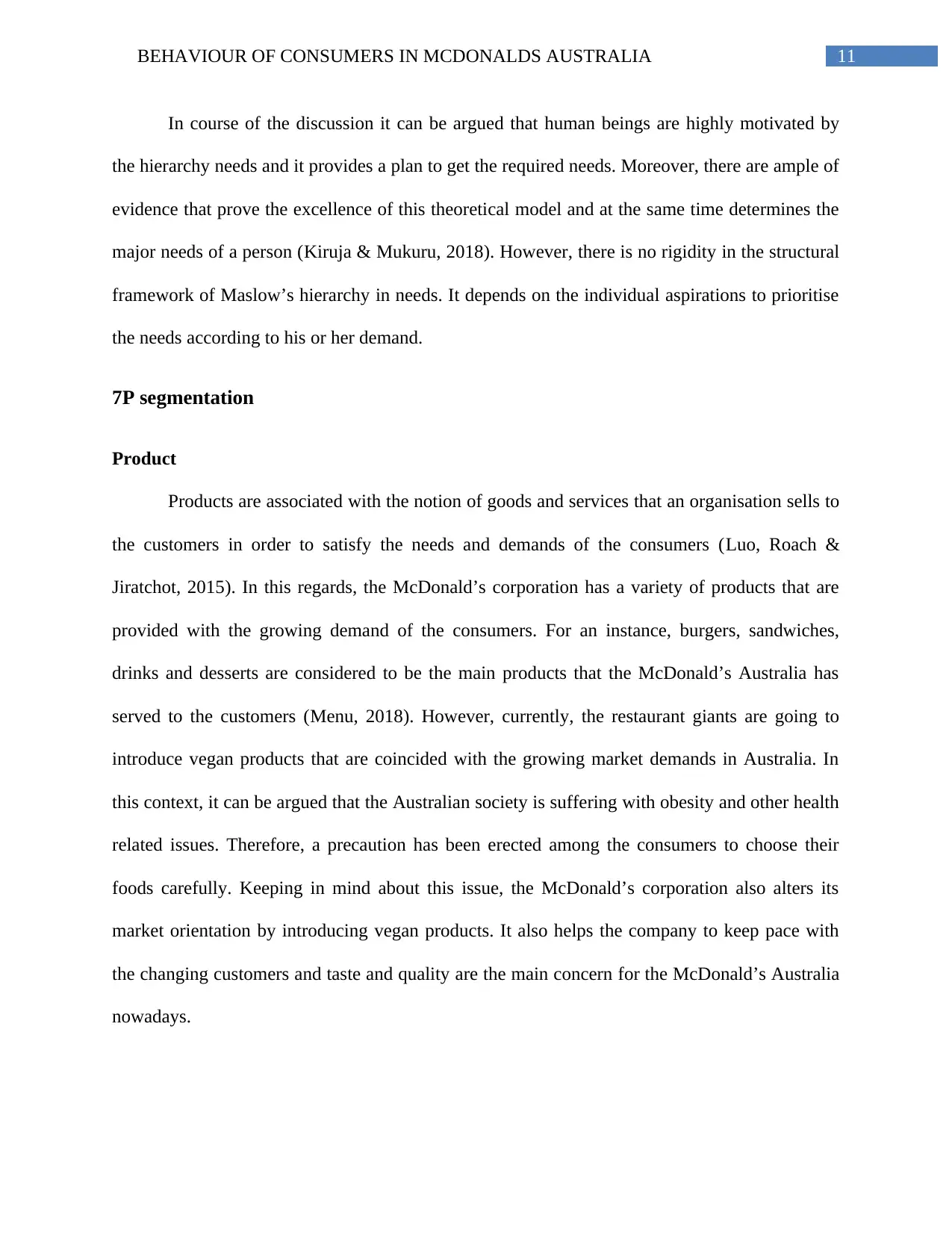
11BEHAVIOUR OF CONSUMERS IN MCDONALDS AUSTRALIA
In course of the discussion it can be argued that human beings are highly motivated by
the hierarchy needs and it provides a plan to get the required needs. Moreover, there are ample of
evidence that prove the excellence of this theoretical model and at the same time determines the
major needs of a person (Kiruja & Mukuru, 2018). However, there is no rigidity in the structural
framework of Maslow’s hierarchy in needs. It depends on the individual aspirations to prioritise
the needs according to his or her demand.
7P segmentation
Product
Products are associated with the notion of goods and services that an organisation sells to
the customers in order to satisfy the needs and demands of the consumers (Luo, Roach &
Jiratchot, 2015). In this regards, the McDonald’s corporation has a variety of products that are
provided with the growing demand of the consumers. For an instance, burgers, sandwiches,
drinks and desserts are considered to be the main products that the McDonald’s Australia has
served to the customers (Menu, 2018). However, currently, the restaurant giants are going to
introduce vegan products that are coincided with the growing market demands in Australia. In
this context, it can be argued that the Australian society is suffering with obesity and other health
related issues. Therefore, a precaution has been erected among the consumers to choose their
foods carefully. Keeping in mind about this issue, the McDonald’s corporation also alters its
market orientation by introducing vegan products. It also helps the company to keep pace with
the changing customers and taste and quality are the main concern for the McDonald’s Australia
nowadays.
In course of the discussion it can be argued that human beings are highly motivated by
the hierarchy needs and it provides a plan to get the required needs. Moreover, there are ample of
evidence that prove the excellence of this theoretical model and at the same time determines the
major needs of a person (Kiruja & Mukuru, 2018). However, there is no rigidity in the structural
framework of Maslow’s hierarchy in needs. It depends on the individual aspirations to prioritise
the needs according to his or her demand.
7P segmentation
Product
Products are associated with the notion of goods and services that an organisation sells to
the customers in order to satisfy the needs and demands of the consumers (Luo, Roach &
Jiratchot, 2015). In this regards, the McDonald’s corporation has a variety of products that are
provided with the growing demand of the consumers. For an instance, burgers, sandwiches,
drinks and desserts are considered to be the main products that the McDonald’s Australia has
served to the customers (Menu, 2018). However, currently, the restaurant giants are going to
introduce vegan products that are coincided with the growing market demands in Australia. In
this context, it can be argued that the Australian society is suffering with obesity and other health
related issues. Therefore, a precaution has been erected among the consumers to choose their
foods carefully. Keeping in mind about this issue, the McDonald’s corporation also alters its
market orientation by introducing vegan products. It also helps the company to keep pace with
the changing customers and taste and quality are the main concern for the McDonald’s Australia
nowadays.
⊘ This is a preview!⊘
Do you want full access?
Subscribe today to unlock all pages.

Trusted by 1+ million students worldwide
1 out of 22
Your All-in-One AI-Powered Toolkit for Academic Success.
+13062052269
info@desklib.com
Available 24*7 on WhatsApp / Email
![[object Object]](/_next/static/media/star-bottom.7253800d.svg)
Unlock your academic potential
Copyright © 2020–2025 A2Z Services. All Rights Reserved. Developed and managed by ZUCOL.

